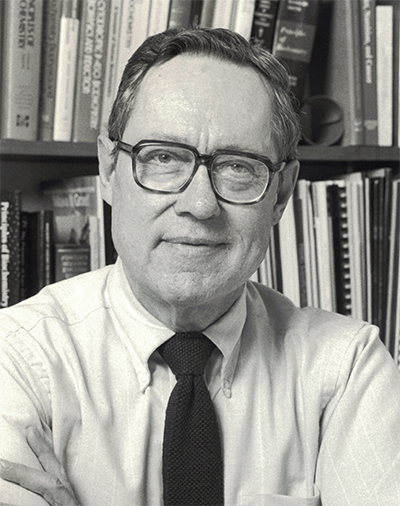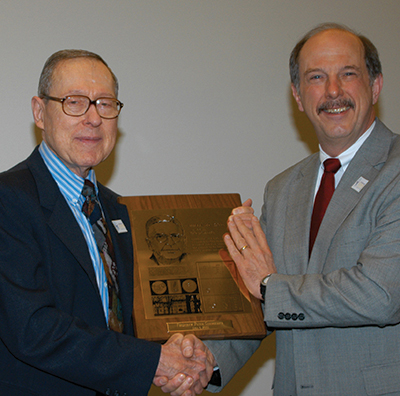Minor J. Coon (1921 鈥� 2018)
Minor Jesser “Jud” Coon was born in Englewood, Colorado, on July 29, 1921, and died Sept. 5, 2018. He was introduced to biochemical research by Reuben Gustavson at the University of Colorado. In 1943, he left to study biochemistry at the University of Illinois under William C. Rose, who came from tracing back to Lafayette Mendel, Russell Chittenden and eventually to J. J. Berzelius.
 Jud Coon, pictured around 1970, was chair of the department of biological chemistry at the University of Michigan from 1970 to 1990.Courtesy of Linda Coon and William Smith/ University of Michigan
Jud Coon, pictured around 1970, was chair of the department of biological chemistry at the University of Michigan from 1970 to 1990.Courtesy of Linda Coon and William Smith/ University of Michigan
Rose is known for discovering threonine and for defining the essential amino acids. Jud and his fellow graduate students did two things: They synthesized amino acids and derivatives, and they consumed synthetic diets lacking one amino acid for weeks. Jud remembered these studies with mixed emotions, mostly bad. At one point, he looked so ill that someone, quoting a line from the musical “Oklahoma,” said, “Pore Jud is daid” — the name stuck.
Doing nutritional experiments on your own graduate students with non-GMP diets would not be allowed today, but Jud said none of them suffered any long-term effects other than the disgusting taste. Jud finished his Ph.D. thesis in 1946, remained in the Rose lab briefly and then in 1947 left for a faculty position at the University of Pennsylvania. The graduate studies had given Jud ideas, and he worked on the metabolism of amino acids.
Leucine catabolism leads to beta-hydroxy-beta-methylglutaryl CoA, now best known because of statin drugs that inhibit cholesterol synthesis. Short-chain acids derived from some of the amino acids can have unpleasant olfactory issues. Jud told me one was the pure essence of dirty tennis shoes and that he got a lot of disgusted looks on the train home at night in Philadelphia.
In 1955, Jud accepted an offer in the department of biological chemistry at the University of Michigan, where he remained for the rest of his life. He took two sabbatical leaves with Nobel laureates, first in 1952 with Severo Ochoa at New York University and then from 1961 to 1962 with Vladimir Prelog at the Eidgen枚ssische Technische Hochschule Z眉rich.
 Jud Coon is pictured around 2010 with Anthony Yu (left), a former postdoc in the Coon lab, and Paul Hollenberg (right), a former student and later chair of pharmacology at the University of Michigan.Courtesy of William Smith/University of Michigan Jud had received the Pfizer Award in Enzyme Chemistry from the American Chemical Society in 1959. After the sabbatical with Prelog, Jud developed an interest in oxidation of hydrocarbons, particularly bacterial . Jud hoped to extend the research to mammalian systems. Omega-oxidation was NADPH-dependent and resided in the microsomal fraction. In the late 1960s, the technology of handling intrinsic membrane proteins was not developed.
Jud Coon is pictured around 2010 with Anthony Yu (left), a former postdoc in the Coon lab, and Paul Hollenberg (right), a former student and later chair of pharmacology at the University of Michigan.Courtesy of William Smith/University of Michigan Jud had received the Pfizer Award in Enzyme Chemistry from the American Chemical Society in 1959. After the sabbatical with Prelog, Jud developed an interest in oxidation of hydrocarbons, particularly bacterial . Jud hoped to extend the research to mammalian systems. Omega-oxidation was NADPH-dependent and resided in the microsomal fraction. In the late 1960s, the technology of handling intrinsic membrane proteins was not developed.
In what might be the , Anthony in separating three components — using glycerol for stabilization and deoxycholate as a detergent — and combining them to reconstitute lauric acid omega-hydroxylation. The three fractions were a cytochrome P450, NADPH-P450 reductase and phospholipid. Anthony told me that they did not even know they were working with a P450 until they took a spectrum one evening in a neighboring lab when that professor was not around. However, none of these components were pure. The reductase was purified to homogeneity by Jud’s student Janice Vermilion. Any of several simple phospholipids for that component. led to the purification of multiple rabbit liver P450s to homogeneity. The difficulties in purifying enzymes from tissues are not always appreciated today; not only are these intrinsic membrane proteins, but they had no affinity tags, and many closely related P450s are present in the crude tissues.
The separation and purification of P450s dramatically changed the landscape of drug metabolism and took it from pharmacology into biochemistry. No longer were catalytic activities alone used to describe reactions, but individual enzymes could be characterized in terms of their roles. The pharmaceutical industry is very different and better off today, in part because of Jud’s contributions.
Purification of an enzyme is not a scientific end but only a beginning. In the 1970s to the 1990s, Jud continued to do research in multiple aspects of P450-related science. an ethanol-inducible P450 in rabbits, resolving some of the controversies about ethanol oxidation systems. He also contributed much to our understanding of the catalytic mechanisms of both P450 and NADPH-P450 reductase, involving his colleagues John Groves and Vincent Massey. Jud published 91 papers in the Journal of Biological Chemistry alone.
From 1970 to 1990, he was chair of the department of biological chemistry at Michigan. He served as secretary (1981-1984) and president (1991-1992) of the 偷拍偷窥 and 偷拍偷窥 Biology. He also headed the advisory committees for the biennial international meetings Microsomes and Drug Oxidations and also Cytochrome P450 for nearly 20 years. Jud was elected to the National Academy of Sciences in 1983. In 1979, he received the ASBMB William Rose Award and in 1980 the Brodie Award in Drug Metabolism from the American Society for Pharmacology and Experimental Therapeutics. He received an honorary Doctor of Medicine degree from the Karolinska Institute, and in 1988 he was named Michigan’s scientist of the year.
 Jud Coon (left) presents the ASBMB William C. Rose Award to F. Peter Guengerich in 2005. Coon studied biochemistry with Rose at the University of Illinois and was the first recipient of the Rose award in 1979.ASBMBHe was a mentor in the true sense of the word. Many of the leaders in the P450 field, both in academia and the pharmaceutical industry, trained in his group. I was fortunate to be a postdoc in his group (1973-1975). I am not sure I appreciated it all then, but I learned many lessons from Jud:
Jud Coon (left) presents the ASBMB William C. Rose Award to F. Peter Guengerich in 2005. Coon studied biochemistry with Rose at the University of Illinois and was the first recipient of the Rose award in 1979.ASBMBHe was a mentor in the true sense of the word. Many of the leaders in the P450 field, both in academia and the pharmaceutical industry, trained in his group. I was fortunate to be a postdoc in his group (1973-1975). I am not sure I appreciated it all then, but I learned many lessons from Jud:
- Hard work pays off eventually.
- Appreciate science.
- Treat your students and postdocs fairly and with respect.
- Focus on things that your lab does well.
- Do not neglect your family.
- Respect individuals you do not agree with; be courteous.
- Contribute to your scientific community — your department or a society, for example.
- Be philosophical; you cannot digest everything at every meeting.
- Don’t worry about lack of lab space; there is always room for another body or piece of equipment.
- Write well!
He was a real stickler on writing. I thought he hated everything I ever wrote. Years after I left, he told me he thought my papers were well-written. I even became an editor, and now I am as hard on my students’ writing as Jud was.
Jud also had another side. He was humorous, witty and enjoyed art and music as well as his family. Jud was married for 52 years to Mary Louise Newbern, whom he met at Illinois. She passed away in 2000, and his son, Larry, also died in the same year.
Jud is survived by his daughter, Susan Coon, and her family and daughter-in-law, Linda Coon, and her family. They both deserve thanks for all their help and care of Jud in recent years, and a number of former students and colleagues maintained close contact with him.
Jud Coon had a long and successful career, and we will miss him. Those of us who trained with him feel a common bond, and I have tried to develop my own laboratory like his. I can pay him no higher compliment as a mentor than this: It was from him that I learned how to be a professor.
Enjoy reading ASBMB Today?
Become a member to receive the print edition four times a year and the digital edition monthly.
Learn moreGet the latest from ASBMB Today
Enter your email address, and we鈥檒l send you a weekly email with recent articles, interviews and more.
Latest in People
People highlights or most popular articles

Unraveling cancer鈥檚 spaghetti proteins
MOSAIC scholar Katie Dunleavy investigates how Aurora kinase A shields oncogene c-MYC from degradation, using cutting-edge techniques to uncover new strategies targeting 鈥渦ndruggable鈥� molecules.

How HCMV hijacks host cells 鈥� and beyond
Ileana Cristea, an ASBMB Breakthroughs webinar speaker, presented her research on how viruses reprogram cell structure and metabolism to enhance infection and how these mechanisms might link viral infections to cancer and other diseases.

Understanding the lipid link to gene expression in the nucleus
Ray Blind, an ASBMB Breakthroughs speaker, presented his research on how lipids and sugars in the cell nucleus are involved in signaling and gene expression and how these pathways could be targeted to identify therapeutics for diseases like cancer.

In memoriam: William S. Sly
He served on the 偷拍偷窥 and 偷拍偷窥 Biology Council in 2005 and 2006 and was an ASBMB member for 35 years.

ASBMB committees welcome new members
Members joined these committees: Education and Professional Development, Maximizing Access, Meetings, 偷拍偷窥, Public Affairs Advisory, Science Outreach and Communication, Student Chapters and Women in Biochemistry and 偷拍偷窥 Biology.

Cadichon honored for academic achievement
She won the State University of New York at Old Westbury鈥檚 Dr. Henry Teoh Award for Outstanding Collegiate Science and Technology Entry Program Graduating Senior, which recognizes exceptional achievement, leadership and promise in a student.

